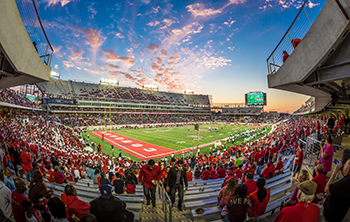Q&A: Planning University Sports Facilities
 Collegiate stadiums and arenas play host to pivotal moments in the lives of student-athletes and serve as a gathering place for fans and members of the broader community. They can even help ensure continued alumni involvement and support the development of college and university sports dynasties.
Collegiate stadiums and arenas play host to pivotal moments in the lives of student-athletes and serve as a gathering place for fans and members of the broader community. They can even help ensure continued alumni involvement and support the development of college and university sports dynasties.
Global design firm DLR Group, which serves clients from 23 locations around the world, has led design efforts for a number of highly regarded collegiate sports facilities since 1987. The firm has in recent years completed the 16,000 seat Pinnacle Bank Arena in Lincoln, Neb., which serves the University of Nebraska women’s and men’s basketball teams; TDECU football stadium for the University of Houston in Houston; PK Park baseball stadium at the University of Oregon in Eugene, Ore.; and Louisiana State University’s 8,550-seat Alex Box Stadium in Baton Rouge, La., among others.
School Construction News spoke with DLR Group Design Principal Greg Garlock, AIA, LEED AP BD+C, and the firm’s National Sports Leader Don Barnum, AIA, about what it takes to design a sports facility that will keep athletes motivated and fans engaged, all while ensuring operational ease and financial success.
Q: What is the most common challenge you encounter during the design of a stadium or arena?
Barnum: One of the key drivers in designing a stadium or arena is how everybody watches the game. The seating bowl, the suites, loge boxes, club spaces — how all of that gets put together is the basis of our job and our responsibility. While that’s a challenge, it’s also an opportunity for great design. All of those premium products have a certain amount of revenue that they generate. We have to make sure that we can build the facility within the amount of money that it’s going to pay back, and that the return on investment (ROI) actually makes sense for the incorporation of those premium products.
Garlock: Another challenge is that many of these facilities become quite large. When we’re talking about a 50,000-seat football stadium or 12,000-seat arena, trying to balance the need to have a capacity like that and create an intimate atmosphere in which people feel close to the action is sometimes a challenge.
Then there’s the magnitude and size of some of these facilities in terms of how they will fit on a campus and not overwhelm their surroundings. We have to look at a number of options to make sure we’re achieving the best blend of all those factors.
Q: Have you noticed any recent design trends specific to collegiate stadiums and arenas?
Garlock: One thing that has really become very prevalent is that these facilities have much stronger connections to their communities, campuses and overall settings. It used to be that these tended to be standalone, inward-looking facilities that really didn’t connect to anything around them. That’s really been flipped completely around in the last several years where we as architects now look long and hard at the campus and community in terms of what is special about that place that we can incorporate in our design. It has created considerably better architecture and friendlier facilities, and made them much more unique and responsive to the owners’ needs.
Barnum: Additionally, what keeps growing is the appetite for premium products. The suites keep getting bigger and nicer, and every building has created some new idea that sets the quality of their product apart from their peers. The reason that’s important is that many universities are competing with other venues in and around their own cities. At the University of Houston, their football stadium is competing for disposable income with professional football and baseball stadiums and other arenas, so they have to be competitive not just with their fellow collegiate institutions but also within their marketplace.
Also, the whole audiovisual aspect of game entertainment is growing. The size of video boards is just unbelievable; they are truly entertainment devices. The game content can also be tied into personal devices as part of the overall entertainment package. The use of smartphones and other devices is driving the entertainment that is produced in the facility. How the fans interact with the event and the institution begins to inform the physical design of the facilities.
Garlock: Fans can just as easily watch the game on their 80-inch big screen television at home with air conditioning, drinks and food, so these facilities and institutions are trying to create experiences that draw people in. We’re helping them develop additional ways to keep it new and exciting, and to create these fantastic environments that people want to be a part of not just once but many times a season. That’s really a challenge for many universities and programs: To keep raising the bar in order to create the best game day experience possible.
Read more of this interview in the September/October issue of School Construction News.
